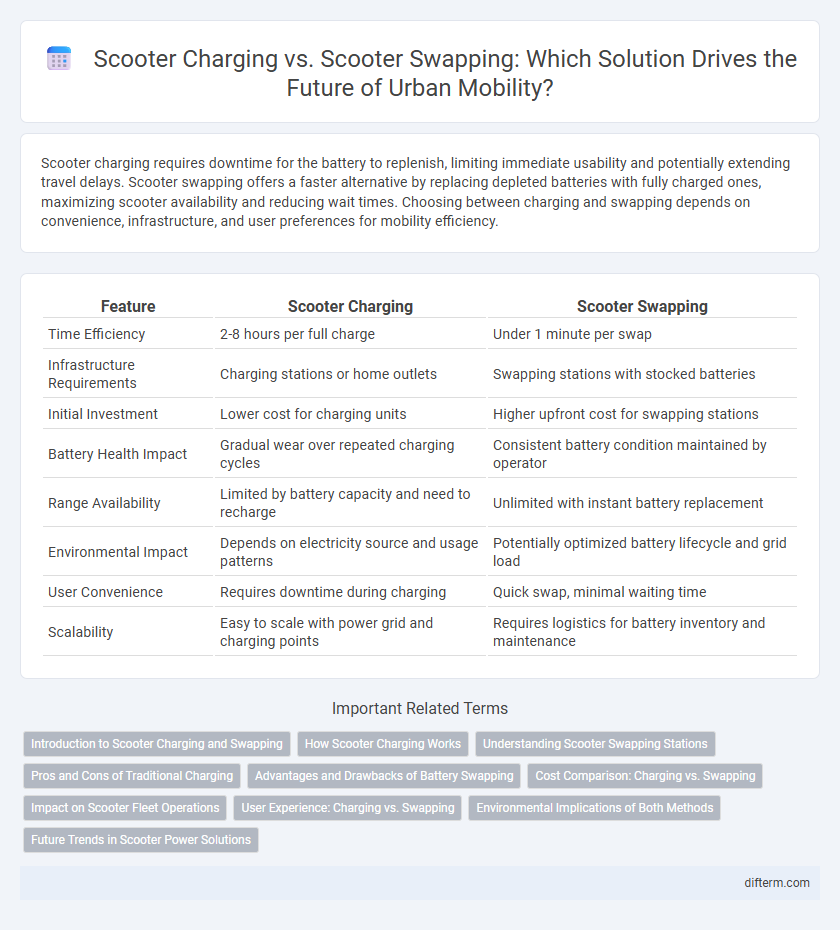Scooter charging requires downtime for the battery to replenish, limiting immediate usability and potentially extending travel delays. Scooter swapping offers a faster alternative by replacing depleted batteries with fully charged ones, maximizing scooter availability and reducing wait times. Choosing between charging and swapping depends on convenience, infrastructure, and user preferences for mobility efficiency.
Table of Comparison
| Feature | Scooter Charging | Scooter Swapping |
|---|---|---|
| Time Efficiency | 2-8 hours per full charge | Under 1 minute per swap |
| Infrastructure Requirements | Charging stations or home outlets | Swapping stations with stocked batteries |
| Initial Investment | Lower cost for charging units | Higher upfront cost for swapping stations |
| Battery Health Impact | Gradual wear over repeated charging cycles | Consistent battery condition maintained by operator |
| Range Availability | Limited by battery capacity and need to recharge | Unlimited with instant battery replacement |
| Environmental Impact | Depends on electricity source and usage patterns | Potentially optimized battery lifecycle and grid load |
| User Convenience | Requires downtime during charging | Quick swap, minimal waiting time |
| Scalability | Easy to scale with power grid and charging points | Requires logistics for battery inventory and maintenance |
Introduction to Scooter Charging and Swapping
Scooter charging involves replenishing the battery by connecting the vehicle to a power source, typically requiring fixed infrastructure and extended downtime. Scooter swapping offers a quick alternative by exchanging depleted batteries with fully charged ones at designated stations, minimizing wait times and enhancing operational efficiency. Both methods play critical roles in urban mobility, impacting range, battery lifespan, and user convenience of electric scooters.
How Scooter Charging Works
Scooter charging involves connecting electric scooters to a power source using a compatible charger, typically through a port located near the scooter's battery. Charging times vary based on battery capacity and charger output, with fast chargers reducing downtime significantly compared to standard chargers. Efficient charging infrastructure, including public and private charging stations, is essential to maintaining scooter availability and supporting urban micro-mobility networks.
Understanding Scooter Swapping Stations
Scooter swapping stations offer a time-efficient alternative to traditional scooter charging by allowing users to exchange depleted batteries for fully charged ones in minutes, significantly reducing downtime. These stations typically feature modular battery packs compatible with a variety of electric scooter models, enabling seamless integration across fleets and promoting scalable urban mobility solutions. By decentralizing energy replenishment, swapping stations alleviate grid load, enhance operational efficiency, and support sustainable transportation ecosystems in densely populated cities.
Pros and Cons of Traditional Charging
Traditional scooter charging offers the advantage of cost-effectiveness and widespread compatibility with existing infrastructure, making it accessible for most users. However, it requires significant downtime for battery replenishment, limiting scooter availability and convenience during peak usage periods. The dependence on station proximity and slower charge speeds can reduce overall operational efficiency compared to fast-swapping alternatives.
Advantages and Drawbacks of Battery Swapping
Battery swapping for scooters offers the advantage of minimizing downtime by enabling instant replacement of depleted batteries, which extends vehicle availability and enhances user convenience. However, drawbacks include the need for standardized battery designs, high infrastructure costs, and logistical challenges related to storage, maintenance, and management of multiple battery units. Despite these challenges, battery swapping promotes sustainability by supporting longer battery lifespans through controlled charging cycles and reducing urban charging congestion.
Cost Comparison: Charging vs. Swapping
Scooter charging typically incurs lower upfront infrastructure costs but results in longer downtime per vehicle, impacting fleet availability and operational efficiency. In contrast, scooter swapping demands substantial investment in swap stations and battery inventory but enables near-instant turnaround, enhancing service continuity and reducing labor expenses. Cost analysis must factor in energy prices, battery lifespan, and scalability, with swapping often proving more cost-effective for high-utilization fleets despite higher initial capital expenditure.
Impact on Scooter Fleet Operations
Scooter swapping significantly reduces downtime by enabling rapid replacement of depleted batteries, enhancing fleet availability and operational efficiency compared to traditional charging. Charging scooters on-site demands substantial infrastructure investment and longer immobilization periods, which can decrease fleet utilization rates. Optimizing scooter swapping logistics supports higher ride demand fulfillment and streamlines maintenance workflows for urban mobility operators.
User Experience: Charging vs. Swapping
Scooter swapping offers users immediate mobility without downtime, eliminating the wait associated with charging. Charging scooters requires significant time, often causing interruptions in user journeys and reducing overall convenience. Swapping stations enhance user experience by providing fully charged scooters instantly, increasing accessibility and satisfaction in urban mobility solutions.
Environmental Implications of Both Methods
Scooter charging typically relies on electricity sources that vary in environmental impact depending on the energy mix, with renewable-powered charging offering significant reductions in carbon emissions. Scooter swapping can reduce downtime and increase fleet utilization but requires infrastructure for battery storage and logistics, which may lead to additional energy consumption and resource use. Both methods necessitate careful consideration of energy sourcing and lifecycle emissions to minimize overall environmental footprints in urban mobility systems.
Future Trends in Scooter Power Solutions
Future trends in scooter power solutions emphasize increased adoption of battery swapping systems over traditional charging methods, driven by urban consumers' demand for minimized downtime. Advances in modular battery design and automated swapping stations enhance efficiency, enabling rapid energy replenishment without the wait associated with conventional charging. Integration of smart grid technology further optimizes energy distribution, positioning scooter swapping as a scalable, sustainable solution in micromobility ecosystems.
scooter charging vs scooter swapping Infographic

 difterm.com
difterm.com